Tagged with 'Tahitian pearls'


The very latest news, musings and opinions from the world of Winterson. Quite simply, a celebration of a jewellery, fashion, culture and the business behind luxury.
-
Savage Beauty: Alexander McQueen
Savage Beauty: Alexander McQueen
Two current exhibitions in London reverentially showcase the work and career of Alexander McQueen (1969-2010), one of fashion's most innovative designers.
Alexander McQueen: Savage Beauty at the V&A and Nick Waplington/Alexander McQueen: Working Process at Tate Britain offer different perspectives on the late designer's talent, influences and processes.
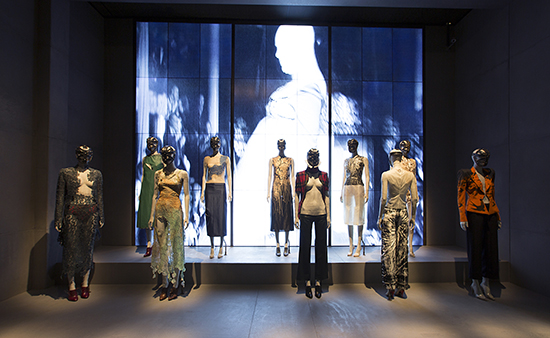
First shown in New York and extended here at the V&A, Savage Beauty is a wonder, a series of rooms filled with gothic fantasy, tribal identity, romantic inspiration and a passion for nature.
The exhibition is structured as a narrative of different collections, starting with McQueen's tailored and revealing bumster trousers, his 1995 Highland Rape collection, 1996's Hunger and the exhilarating Horn of Plenty from 2009.
The exhibition finale recreates 2010's Plato's Atlantis collection, a futuristic and thrilling fusion of technology and fashion, complete with its famous Armadillo shoes.
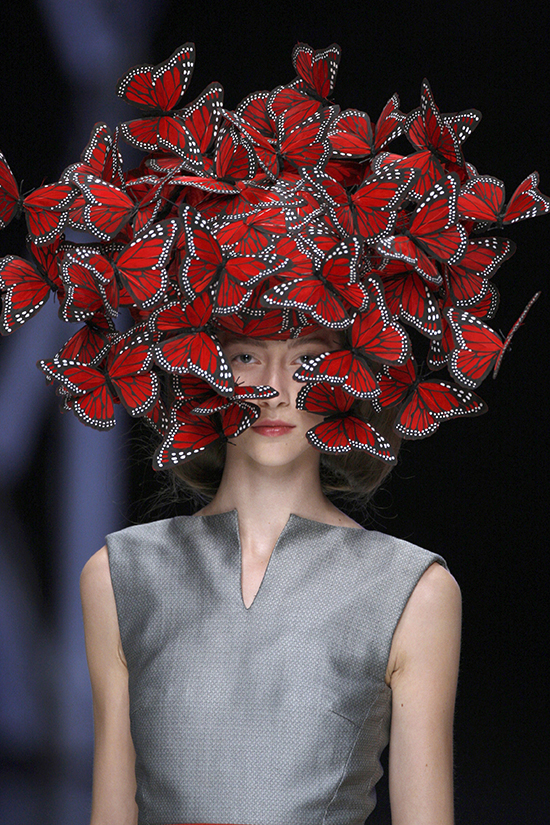
Deeper within the exhibition is the dramatically macabre Cabinet of Curiosities.
This centrepiece room is a spectacular double-height gallery showing archive video footage from McQueen's catwalk shows and accessories, including a butterfly headdress of hand-painted turkey feathers (pictured above) by milliner Philip Treacey.
Jewellers Sarah Harmarnee and Shaun Leane feature prominently. Leane was a long-time collaborator of McQueen, having first met at Central Saint Martins in London.
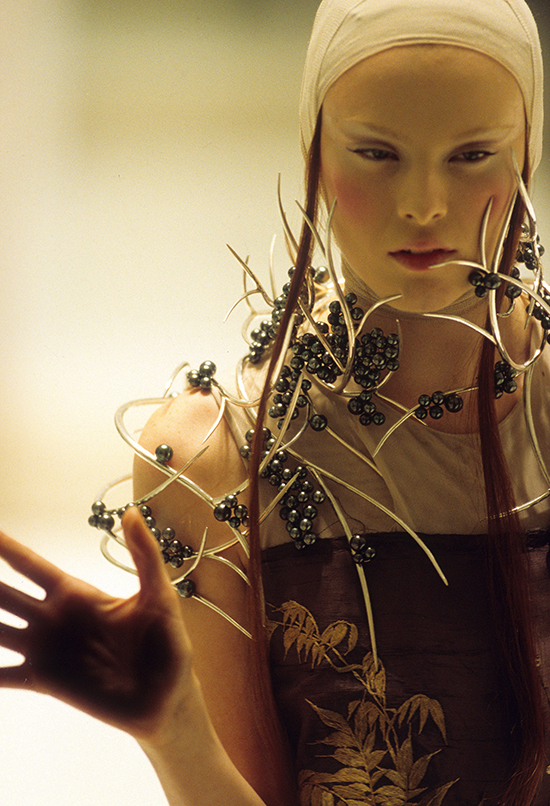
Leane's distinctive aesthetic is recognisable in the pieces shown in the Cabinet - a Tusk earring for McQueen's Hunger S/S 1996 collection and this neckpiece (pictured above) with silver thorns and grey Tahitian pearls from 2001.
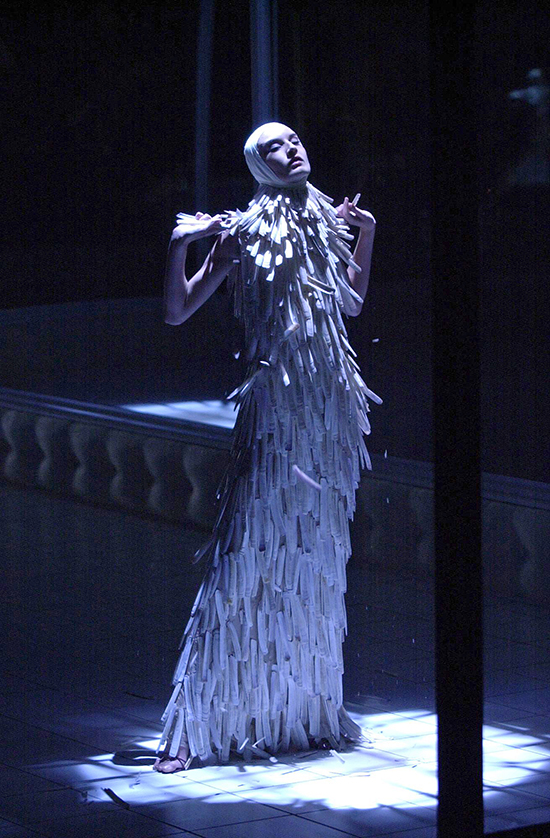
Performance and footage from McQueen's shows feature throughout the exhibition, with one highlight being a hologram of Kate Moss floating eerily in the finale to the 2006 Widows of Culloden show.
The staging of the exhibition has been beautifully done with many pieces such as the razor clam dress (pictured above), arguably being close to works of art themselves.
A must-see retrospective, this exhibition gives a glimpse of the extraordinary and creative talent at work.
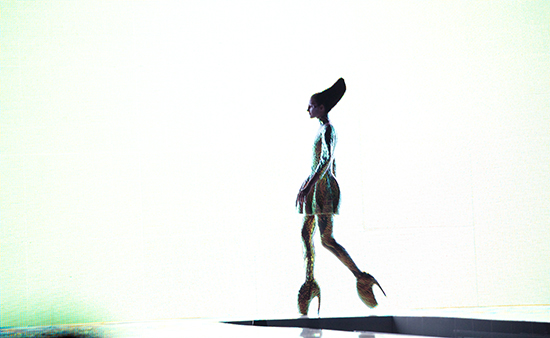
On McQueen's right arm was a tattoo, with words from A Midsummer Night's Dream 'Love looks not with the eyes, but with the mind'.
If you are left wanting more, it would be to understand and hear from McQueen himself.
Savage Beauty is open at the V&A, London until 2 August 2015. -
Introducing the Lief Collection to Winterson
Introducing the Lief Collection to Winterson
This week we are delighted to launch a new collection of jewellery called Lief, which is also the old English word for "Beloved".
The newly launched Lief collection has been designed by our new Creative Director Alice Cicolini, who first began working with Winterson in 2013.
ALICE CICOLINI
Alice is a successful jewellery designer, creative commissioner and producer, with her work currently being stocked at Net-A-Porter, Dover Street Market, Urban Flower Grange Hall and Colette.
Her first collaborative collection with us called ‘Beau’ - a flamboyantly British range of seed pearl jewellery – is available exclusively at Winterson.
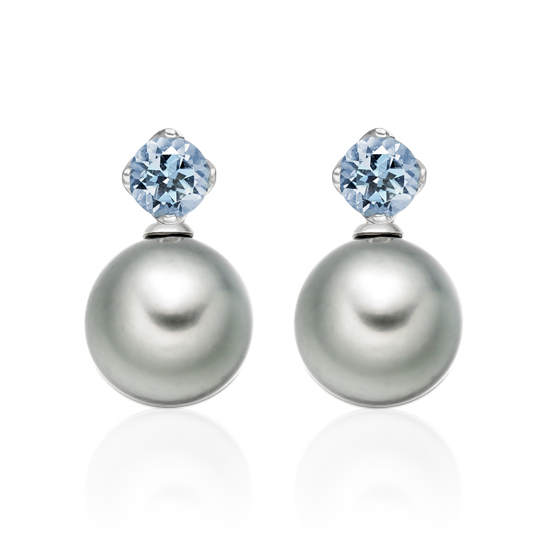
In her official Winterson role, Alice will be responsible for the creative conception and product development of the classic, bridal and fine jewellery collections at Winterson. She will also establish and manage our exclusive collaborations with other up and coming British designers.
Alice brings a distinctive style and influence to our jewellery that has already inspired our customers with her Beau collection, rings and earrings. We are delighted to welcome her fully to our team.
THE INSPIRATION FOR LIEF
The new Lief collection is based on the Winterson brand motif, which is inspired by a wild northern flower called Linnaea Borealis.

This little alpine twinflower is named Carl Linnaeus, a world renowned Swedish botanist who is also believed to have been the first to culture successfully a spherical cultured pearl.
Alice's designs for Lief are an exquisite fusion of colourful gemstones and diamonds with Winterson’s signature pearls. Clever interchangeable design allows the wearer to create different looks across the collection, from everyday to the more formal.
Three designs beautifully capture the essence of spring and colour and will be an exciting range of enduring classics to treasure.
LIEF, ENCHANTED AND ENTWINED
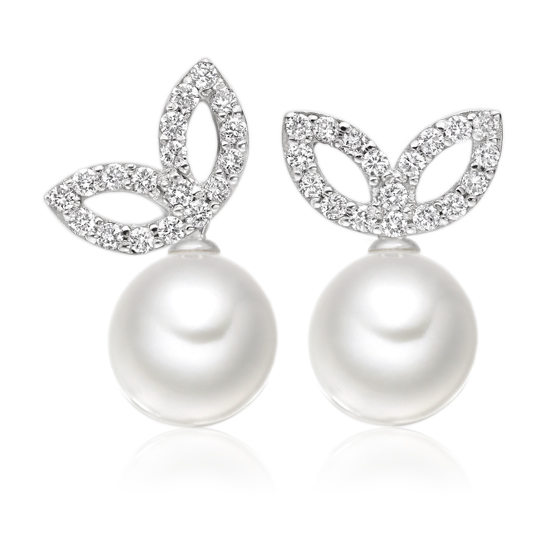
The new Enchanted Diamond Earrings sparkle with 36 ice clear gems and are finished in white and yellow gold. Stunning on their own, they can also be combined with a selection of our carefully chosen pearls, crafted with an 18 carat gold loop and expertly designed to fit the Lief stud earring earpost.
New elegantly understated studs also join the range with a beautiful selection of gemstones to tempt, from soft Morganite and Green Beryl, to vibrant Pink Tourmaline, Aquamarine and Amethyst. Each stud earring can be paired with white Akoya or Freshwater Drop pearls, naturally grey Tahitian pearls, or simply worn on their own.
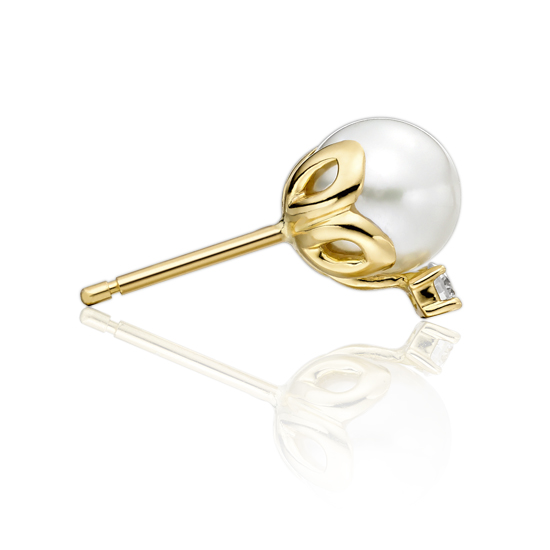
New Entwined Pearl Stud Earrings feature wild gold leaves, entwined around a pair of white Akoya pearls and adorned with two round white sparkling diamonds.
Discover the Lief collection here.
-
Three Pearl Trends For 2014
Three Pearl Trends For 2014
The world of the cultured pearl is always changing, with each year bringing a new set of pearl trends to discover as pearl farmers adapt their production and develop new techniques.
Our buying team recently returned from Asia with a stunning selection of the highest quality pearls for our collections of jewellery at Winterson, being carefully chosen for their lustre, colour and beauty.
But there were a few surprises too.
Here are our reflections from the visit and a prediction of pearl trends for the coming year:
SMALL SIZES…
Pearls above 11mm in diameter command a significant premium for their rarity, particularly for the highest quality South Sea and Tahitian pearls.
But this year more than ever before, we noticed that pearl sizes smaller than 7-8mm diameter, for the Akoya pearl and even seed pearls as small as 1-2mm, are very much in demand for necklaces, earrings and other types of jewellery.
Comfortable to wear and elegantly proportioned, these are the classic pearl sizes for a jewellery designer to work with.
THE EVER CHANGING FRESHWATER PEARL…
The shift in production and demand for Freshwater pearls over the past thirty years has been significant, with small cereal shaped pearls being steadily replaced by the introduction of rounder shapes, and more recently by larger nucleated pearls.
This year really is no exception. Round nucleated Freshwater pearls are now widely available in sizes above 12mm. The trend of the last few years towards large oversized baroque shapes in contemporary jewellery seems to be falling out of fashion.
Perhaps more concerning was the apparent level of processing treatment of some of the larger pearl sizes. Although designed to achieve a whiter colour, these pearls might lose their lustre over time. If in doubt, always buy from a retailer that specialises in pearls.
We only select the highest quality Freshwater pearls that we can find and we loved the dazzling metallic colours of the pearl drops above!
THE NEW WHITE IS…GOLDEN?
The boutiques and shops of Hong Kong are filled with many of the world’s luxury and fashion brands.
The Chinese home market of shoppers loves pearls and prices for high quality pearls are increasing with the growth in Asian markets.
Classic pearls that have a natural-looking white colour are the most favoured style, but it is the luxurious golden South Sea pearl, with its rich tones of champagne, gold and burnt orange, that is the most highly sought after pearl this year.
PREDICTION FOR 2014
The world of pearls is so varied that it is difficult, almost impossible, to summarise one single prediction for this organic gem next year.
Perhaps the most exciting trend is the popularity of small sizes - we are going to see more jewellery designers working with classic white pearls in many subtle, intricate and intriguing ways in 2014.
-
What are Peacock Pearls?
What are Peacock Pearls?
The very name itself - Peacock Pearls - conjures up an image of an iridescent, beautiful gem with a myriad of shimmering colours. Are these pearls real and what are the qualities that give Peacock Pearls their colourful name?
A peacock pearl describes one of the most valued and sought after colours of a type of saltwater pearl called the Tahitian pearl, which are cultured in French Polynesia in the black-lipped oyster Pinctada margaritifera.
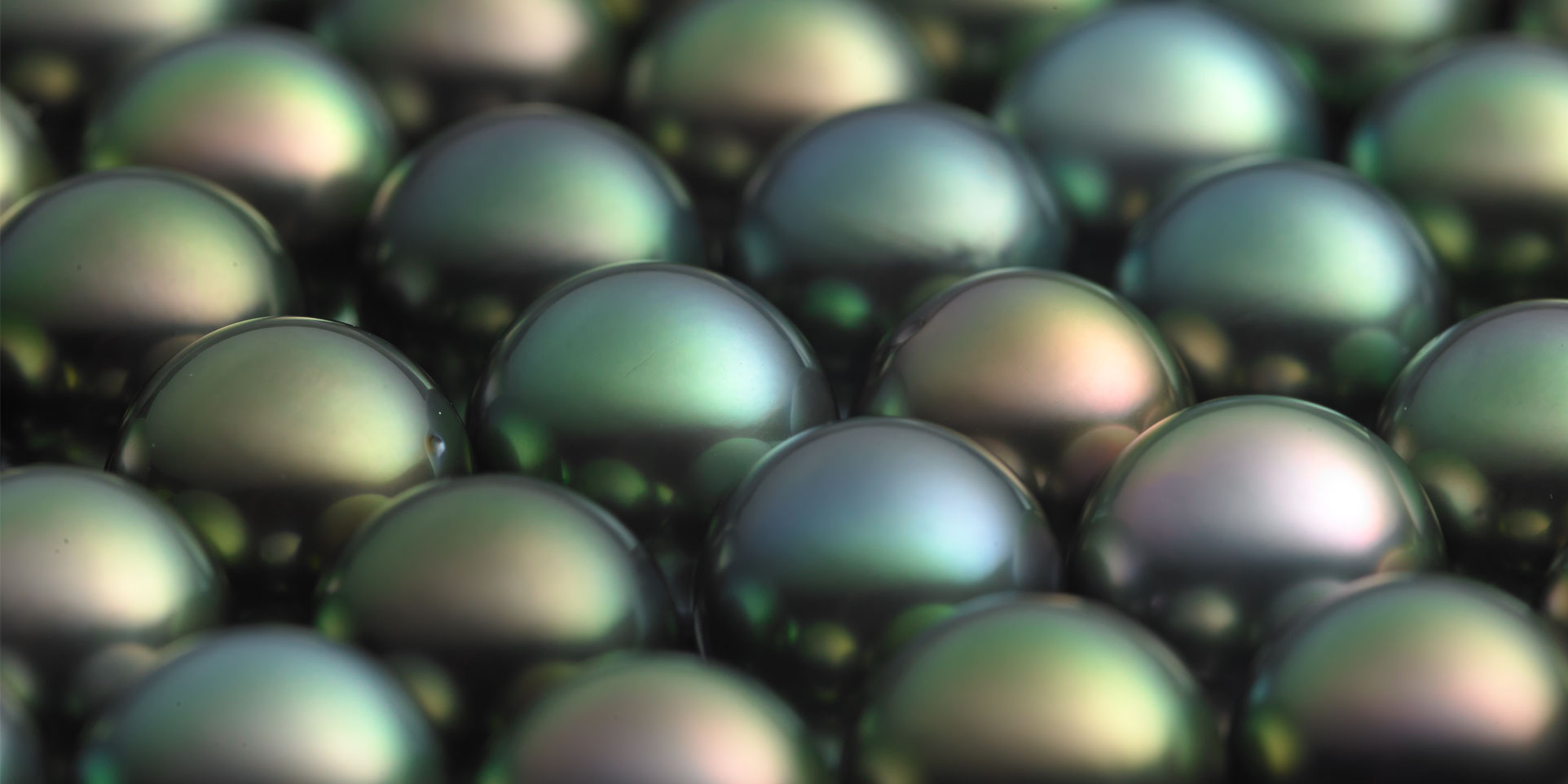
Image: Peacock Tahitian Pearls
With a dark grey-green body colour, a true peacock pearl will have a pink, purple or golden overtone of colour that appears to float on the surface of the pearl as the light catches it. These natural iridescent colours are achieved without any artificial dye or treatment.
What causes these special colours?
The dark body colour of the Tahitian pearl comes from the pigments and trace elements in the water that the oyster lives in.
The reason for the colour and strength of the overtone of each pearl, however, also depends on other factors. Scientists believe that the peacock's striking plumage is thought to be caused by the different ways that light is reflected at angles by the structure of the bird's feathers. Just as with the peacock, the layers of nacre on the curved surface of a pearl can have the same effect.

Image 1: Enchanted Lagoon Earrings in White Gold
Image 2: Luna Moss Tahitian Pearl and Sapphire Ring
Optical interference creates the complexity of each pearl's colour. The shape of the pearl, and the thickness and transparency of its nacre, can contribute in varying degrees to the colour's intensity.
Artificial colour treatments for peacock pearls
Since pearls were cultured early in the 20th century, there have been many attempts to reproduce artificially the peacock colours of a Tahitian pearl.
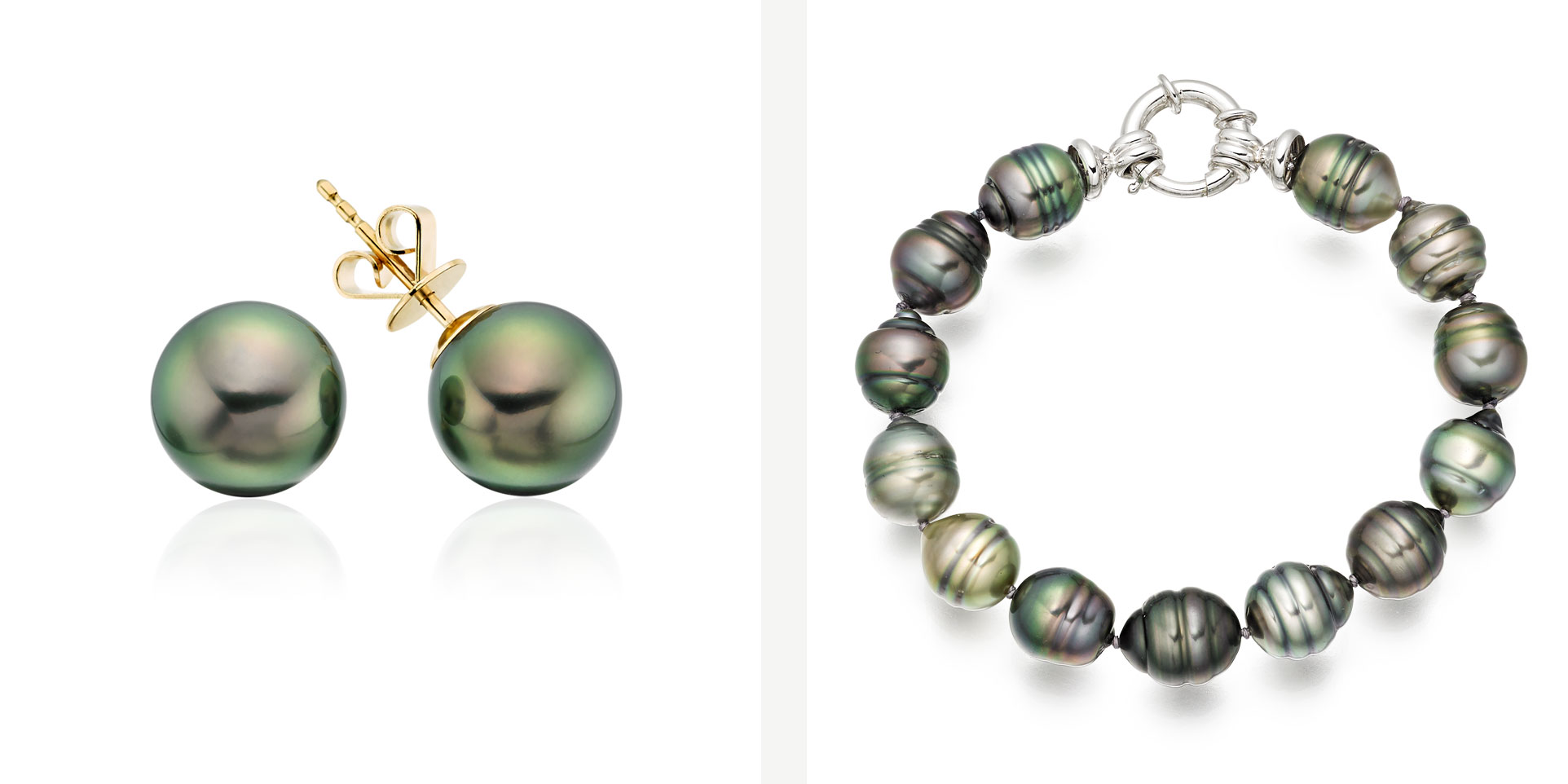
Image 1: Peacock Tahitian Pearl Stud Earrings in Yellow Gold
Image 2: Multi-coloured Baroque Tahitian Pearl Bracelet in White Gold
The exact techniques used are not well-known, but may involve the use of silver nitrate solutions to darken the pearl, other colouring agents such as organic dyes to produce a blue, purple, green or brown hue or gamma ray irradiation to darken the pearl itself.
Many black pearls sold today are Chinese freshwater pearls that have been treated. These treatments would be quite obvious to an experienced pearl expert or retailer as they are not an exact match to the real peacock colouring. Some dye treatments may also show some colour differences or fading over time, so ask your retailer if unsure.
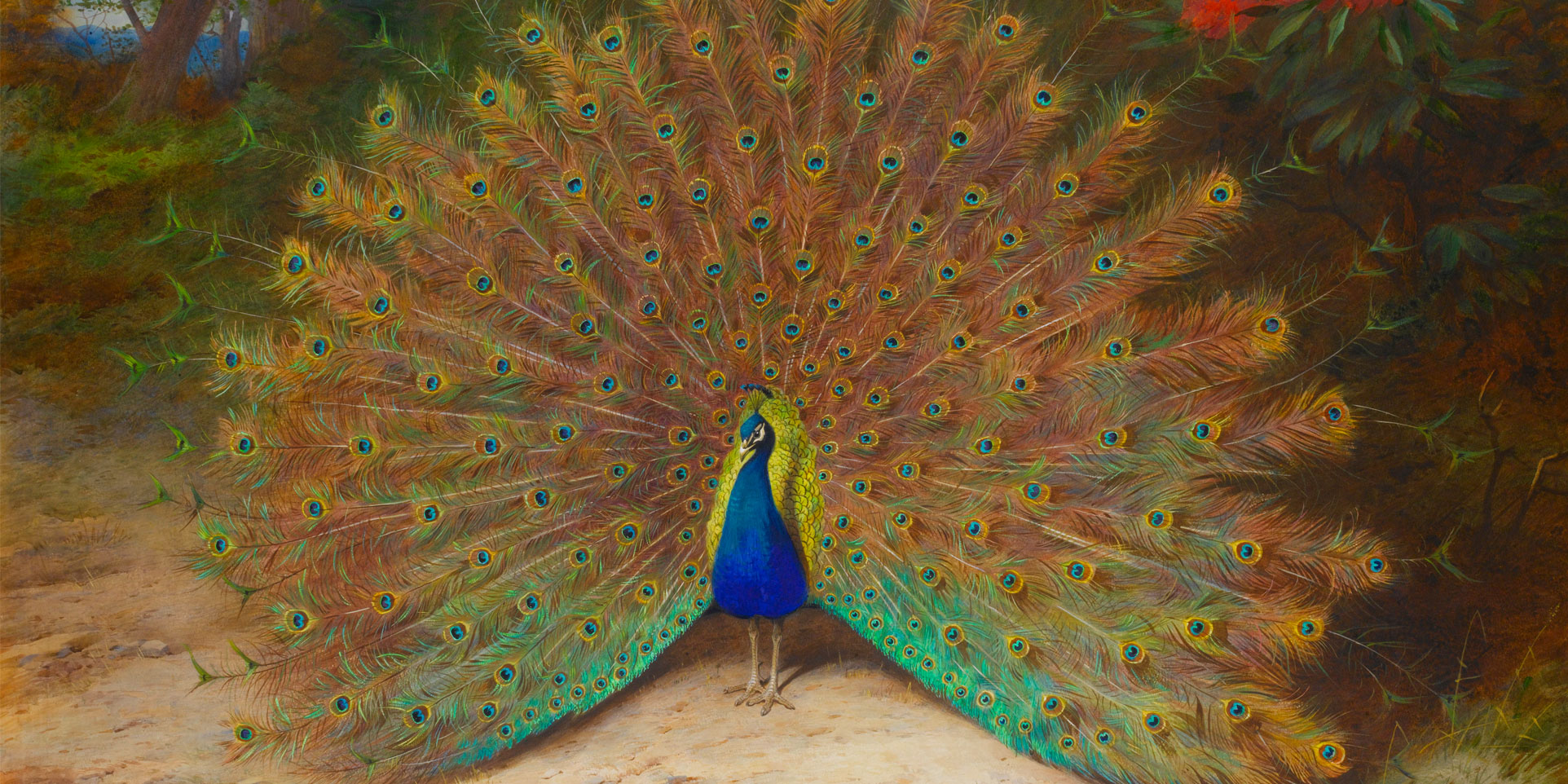
Image: Peacock and Peacock Butterfly, Archibald Thornburn, 19th century
Genuine Tahitian pearls are also prized for their relative rarity in comparison to freshwater pearls, and, like the silvery-white and golden South Sea pearls, are considered to be some of the finest examples of this extraordinary gem.
As with all rare pearls, this is reflected in their relative pricing, which is another way to distinguish this queen of gems from the dyed freshwater variety.
Proud as a peacock
We love the more natural colours and overtones of the peacock pearl and have a beautiful range of jewellery at Winterson that showcases the extraordinary natural rainbow overtones of these amazing peacock pearls.
Read our Journal article on Selecting Fine Pearls if you would like to know more.
-
Just Another Day Selecting Fine Pearls
Just Another Day Selecting Fine Pearls
Our buying team returned this week from Hong Kong with a new selection of fine pearls for our jewellery collections.
Hong Kong is the centre of the pearl business today, with dealers and pearl farmers from around the world sorting and selecting through the best (and the worst) of the new season's harvest of cultured pearls.
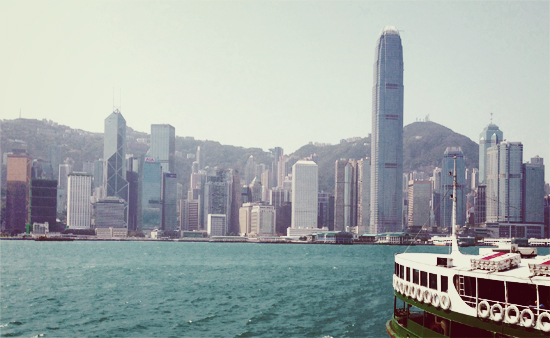
The size of this jewellery show also makes it one of the biggest in the world, with over 42,000 buyers from 140 different countries. Finished jewellery, brands and designers exhibit alongside the glittering distraction of rows upon rows of diamonds, precious gemstones and pearls.
With three main jewellery fairs in Hong Kong a year, the March and June exhibitions are the best time to view and select from the new harvest. This is because most pearls are harvested when the water is cool. Colder temperatures are believed to improve the quality of the lustre of the pearl.

Most sellers in the main part of the jewellery fair are wholesalers, but a number of the big pearl farmers and trade groups from the pearl producing regions of Tahiti, Australia and Indonesia also hold auctions by invitation to try and obtain the best prices for their new harvest.
In high demand this year were golden pearls from Myanmar, famed for their deep rich, burnt orangey golden colour. Prices for some pearls were reported to be reaching 5-8 times the seller's asking prices.
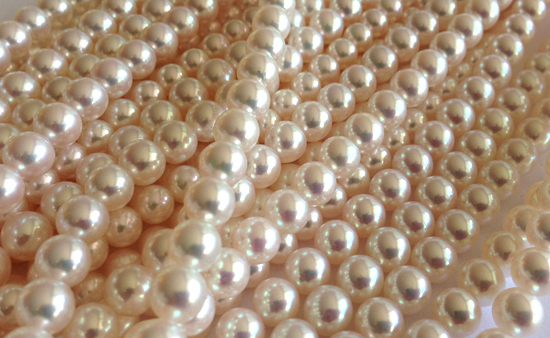
This is where it can take years of experience to be able to select a lot of fine pearls from the many others, recognising the excellent quality of nacre that gives the exceptional Akoya pearls above their mirror like shine, or the telltale signs of when a pearl's lustre is fading.
A typical pearl auction is held in a large quiet room away from the bustle of the main jewellery fair. Perhaps up to 300 or 400 different lots of loose pearls are arranged in bowls along long tables. Each lot will be comprised of between a few hundred to 5,000 individual pearls, sorted by shape, colour and quality, but usually mixed by size.
Buyers select a bowl that they are interested in, ask for it to be weighed and then search for a clear table with good, natural daylight to look at the pearls in each lot.
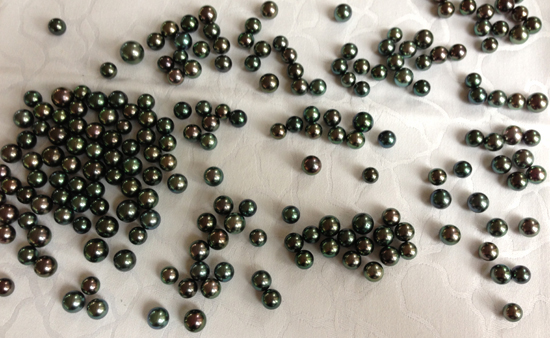
Sorting through such a large group of pearls such as the one above can be a daunting and rewarding challenge. It is important to think about the eventual use of the pearls in jewellery, their various grading qualities in terms of lustre, shape, colour and surface. Higher quality pearls will be used for earrings and pendants, whilst slightly less perfect pearls tend to be made into necklaces.
If everything looks good, the final stage of the auction is to make a sealed bid. A price in Japanese yen, dollars or euros (depending on the particular auction) is written on a small ticket and dropped into a ballot-like box.
A short wait follows, until the auction closes, before it is possible to see if your bid is ultimately successful.

Amongst our immediate favourites from this trip's selection were the beautiful dark Tahitian pearls picture above, with their gorgeous natural colours of peacock purple, cherry, aubergine, blue and green.
Over the next few months, we will be introducing these gems to Winterson.
-
Introducing Pearl Rings to Winterson
Introducing Pearl Rings to Winterson
Launching this Autumn at Winterson, our new collection of Pearl Rings celebrates the enchanting beauty and subtle luxury of the pearl.
One of the earliest forms of adornment by women, the ring has taken many forms since its ancient beginnings as a simple band of silver or gold. Today the ring is one of our most precious pieces of jewellery, with the symbolism of a wedding ring or the fashionable drama of an eye-catching cocktail ring.
Before diamonds became forever associated with engagement rings, rings made with natural freshwater and saltwater pearls were also the romantic and popular choice of gemstone for a new bride.
The inspiration for the designs of the first pieces in this collection of pearl rings was to celebrate this heritage with a simple classic, and contemporary design. Each ring is crafted in Britain from 18 carat white or yellow gold, with the band of the metal having a angular sharpness to its outside edge whilst being rounded on the inside for comfort.
Set into the beautifully proportioned shoulders of the gold ring are two types of saltwater pearls. The first is a round white Akoya pearl, a classic pearl that is much admired for the quality of its lustre and shine. The second type of pearl chosen for the collection is a Tahitian pearl, which has a naturally grey colour with overtones of light green and pink.
Set into yellow gold, with a sparkling trio of white round brilliant cut diamonds on either side, the Tahitian Pearl and Diamond Yellow Gold Ring is already a firm favourite at Winterson.
All the rings are now available for order in a standard UK size M, which is a standard 6¼ size in the United States. It is possible for each ring design to be be resized to accommodate most ring sizes. Please contact us for more details if you would like some more information about ring sizes.
-
Freshwater pearls or saltwater pearls?
Freshwater pearls or saltwater pearls?
Here is a simple question. How many freshwater pearls are there in this image ?
Pearls have fascinated us for hundreds of years with their colours, shapes and diversity. Despite our long love story with pearls, our general knowledge of these pretty and precious gems is still relatively poor. A simple test of our understanding is whether we can explain the difference between a freshwater and a saltwater pearl…
Saltwater pearls include Akoya pearls historically from Japan, Tahitian pearls from French Polynesia and South Sea pearls from Australia and Indonesia, whilst Freshwater pearls today originate mainly from China. The difference between saltwater and freshwater pearls is not their geographic origin, however, but in the mollusks in which they originate.
Saltwater pearls are found in oysters that live in saltwater oceans and seas, whilst freshwater pearls are found in mussels that live in freshwater rivers, lakes and ponds.
Both saltwater and freshwater pearls are formed with a similar process. All pearls are formed as the mollusk secretes layers of a protective iridescent substance called nacre around an irritant. In natural pearls an irritant such as a parasite enters the mollusk, whereas with cultured pearls, this irritant is introduced intentionally by man. Experts define both saltwater and freshwater pearls as ‘pearls’ for they have concentric layers of nacre.
Both freshwater and saltwater pearls make beautiful jewellery. Their unique characteristics of each variety make it not too difficult to distinguish a freshwater pearl from a saltwater pearl by looking at its natural colour, its shape, its size and whether the pearl has a bead nucleus inside. Metallic pastel colours, for example, are a clear sign that a pearl is of freshwater origin. A knowledgeable eye might look at the drill hole of the pearl to determine if there is a shell bead nucleus inside.
Continual advances in pearl farming techniques, for example with the introduction of round beaded nuclei to help make larger round freshwater pearls, are making some of these differences harder to identify. With some significant differences in price between freshwater and saltwater pearls, it is always advisable to purchase pearls from a reputable jeweller.
PS The answer above is that there are 5 cultured freshwater pearls in the image above, the rest are all cultured saltwater pearls.
-
In Search of Black Pearls
In Search of Black Pearls
2011 is the 50th anniversary of the first successful experiment to grow cultured pearls in French Polynesia.
Jean-Marie Domard, a Frenchman who had studied pearl grafting at the farm of Mikimoto, located the first Tahitian pearl farm at Hikueru, an atoll in the Tuamotu archipelago situated approximately 750km from the capital of French Polynesia. Hikueru, which was visited by the famed Portuguese explorer Ferdinand Magellan in 1521, was a perfect breeding ground for the black lipped oyster.
Despite their name Tahitian pearls are confusingly known as 'black pearls' as a result of taking on the colour of the black lipped Pinctada margaritifera cumingii oyster. These pearls are formed though in many exotic colours such as silver, grey, pistachio, peacock and aubergine.
Initially the industry believed these incredible colours to be the result of a post-culturing treatment.
Following confirmation by the laboratory of the Gemological Institute of America (GIA) that the colour was indeed natural, the first production of cultured pearls from French Polynesia began to be marketed successfully in the US and Europe during the 1970s.
Amongst the most beautiful pearls in the world, Tahitian pearls are farmed today in warm saltwater lagoons, mainly throughout French Polynesia. No pearls are actually cultured in Tahiti itself, with the main farms being as far as 1500km away on remote atolls and islands. Their locations are chosen for their reefs that provide protection from tides, access to free flowing warm water and environmental purity.
Combined with classic round and baroque shapes, these colourful pearls have become highly fashionable and sought after. Whether made as a choker necklace, a unique multi-coloured pearl necklace or with the simplicity of a Tahitian pearl pendant or Tahitian pearl earrings, these pearls perfectly match the exotic surroundings of their source.
-
Buying Pearls in Hong Kong
Buying Pearls in Hong Kong
The historic Star Ferry has ploughed its way across Hong Kong harbour since the late 1880s. The crossing is named by National Geographic Traveler as one of their 50 Places of a Lifetime.
When the sun is shining, the sea turns a petrol green colour and with that magnificent skyline, there can be few better ways to get to work in the morning or places for buying pearls.
For the last four days, Hong Kong has been host to the largest Spring Jewellery Show in Asia, with more than 30,000 buyers and suppliers attending from around the world – a record attendance despite recent times.
In pearl terms, Hong Kong has grown to be one of the most important pearl trading centres in the world and this is one of the key dates in the annual calendar for buying pearls. It is hard to comprehend the size of the pearl industry until confronted by more than 10,000 square metres of pearls for sale at this Jewellery Show.
The new season’s freshwater pearls from China are available to the market for the first time and prestigious pearl famers such as Robert Wan from Tahiti and Paspaley from Australia offer their pearls at auction to a select specialist group of buyers.
Pearl prices are beginning to rise again. Demand for these incredible gems is increasing, particularly from customers in India and China, whilst production over the last two years has been reduced as pearl farmers have weathered the global crisis.
This is particularly true of larger Freshwater, Akoya, Tahitian and South Sea pearls and higher grade quality pearls are in much shorter supply now. With minimum lead times of 18 months to over 3 years for farmers to increase their pearl harvest, it is likely that this trend will continue for the foreseeable future, especially for the premium grade pearls.
It is a good time to buy pearls and we will have many beautiful pieces of pearl jewellery to show you at Winterson over the coming months.
-
What are Baroque Pearls ?
What are Baroque Pearls ?
When describing the shape of a pearl, baroque is a term that is used to describe irregular and non-symmetrically shaped pearls that have been formed in freshwater mussels and saltwater oysters. Baroque pearls are not round, drop or button shaped.
The shape of a baroque saltwater pearl is caused by the uneven deposition of nacre by the oyster around its nucleus.
Up to 40% of the harvest of cultured pearls from a Tahitian pearl farm can be baroque in shape. These generally are found to be smaller in size, with true Tahitian baroque pearls greater than 12mm being very rare and sought after.
Larger Australian South Sea baroque pearls are also unusual and particularly beautiful, with a silver blue overtone and beautiful lustre.
Baroque pearls have been used for many years to create wonderful pieces of jewellery. One of the most famous historical pieces of baroque pearl jewellery is The Canning Jewel. To be found today in London’s Victoria & Albert Museum, it is believed to have been made in the 19th century and uses a number of baroque pearls to create its mythical Merman figure.
Baroque pearls today are less extravagantly worn, but are still highly sought after for their individual shapes and colours. Today, baroque pearls are inspiring a new generation of contemporary fine jewellers, from Melanie Georgacopolous to Mizuki, drawn to their unique forms.
At Winterson, we stock a range of necklaces, baroque pearl earrings, sautoirs and bracelets made from Tahitian baroque pearls. Each pearl is unique and its contours, circles and peacock colour creates a sophisticated and highly contemporary look.